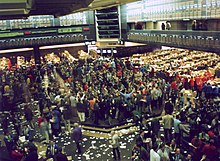
Back Mercat de ròdols Catalan Gadehandel Danish Parketthandel German Mercado de corros Spanish Vente à la criée French 立ち会い取引 Japanese Open outcry Dutch




Open outcry is a method of communication between professionals on a stock exchange or futures exchange, typically on a trading floor. It involves shouting and the use of hand signals to transfer information primarily about buy and sell orders.[2] The part of the trading floor where this takes place is called a pit.
In an open outcry auction, bids and offers must be made out in the open market, giving all participants a chance to compete for the order with the best price. New bids or offers would be made if better than previous pricing for efficient price discovery. Exchanges also value positions marked to these public market prices on a daily basis. In contrast, over-the-counter markets are where bids and offers are negotiated privately between principals.
Since the development of the stock exchange in the 17th century in Amsterdam, open outcry was the main method used to communicate among traders. This started changing in the latter half of the 20th century, first through the use of telephone trading, and then starting in the 1980s with electronic trading systems.
As of 2021[update], a few exchanges still had floor trading using open outcry. The supporters of electronic trading claim that it is faster, cheaper, more efficient for users, and less prone to manipulation by market makers and broker/dealers. However, many traders still advocate for the open outcry system on the basis that the physical contact allows traders to speculate as to a buyer/seller's motives or intentions and adjust their positions accordingly. As of 2010, most stocks and futures contracts were no longer traded using open outcry due to the lower cost of the aforementioned technological advances. As of 2017, open outcry in the United States was very limited, such as in a much more stream-lined form at the Chicago Board of Trade owned by the CME Group.[3]
- ^ https://www.nyse.com/pdfs/Next_Generation_Model.pdf Archived 17 October 2012 at the Wayback Machine NYSE Next Generation Model fact sheet, 2008
- ^ "The Art of Hand Signals" (PDF). Archived from the original (PDF) on 5 February 2012. floor trading hand signals ( 455 KiB)
- ^ ""Open outcry" is in retreat but futures and options trading-volumes surge". The Economist. 5 January 2017. ISSN 0013-0613.